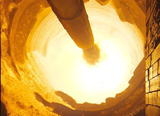Our customers' most commonly used types and varieties of cement are the following:
Gray Ordinary Portland Cement
Our Gray Ordinary Portland Cement is a high-quality, cost-effective building material—mainly composed of clinker—that meets all applicable chemical and physical requirements and is widely used in all construction segments: residential, commercial, industrial, and public infrastructure.
White Portland Cement
CEMEX LatAm is one of the world's largest producers of White Portland Cement. We manufacture this type of cement with limestone, low iron content kaolin clay, and gypsum. Customers use our White Portland Cement in architectural works requiring great brightness and artistic finishes, to create mosaics and artificial granite, and for sculptural casts and other applications where white prevails.
Masonry or Mortar
Masonry or mortar is a Portland cement that we mix with finely ground inert matter (limestone). Our customers use this type of cement for multiple purposes, including concrete blocks, templates, road surfaces, finishes, and brick work.
Oil-well Cement
Our oil-well cement is a specially designed variety of hydraulic cement produced with gray Portland clinker. It usually forges slowly and is manageable at high temperatures and pressures. Produced in classes from A to H and J, our oil-well cement is applicable for different depth, chemical aggression, or pressure levels.
Blended Cement
Blended hydraulic cements are produced by intergrinding or blending Portland cement and supplementary cementitious materials or SCM such as ground granulated blast furnace slag, fly ash, silica fume, calcined clay, hydrated lime, and other pozzolans. The use of blended cements in ready-mix concrete reduces mixing water and bleeding, improves workability and finishing, inhibits sulfate attack and the alkali-aggregate reaction, and reduces the heat of hydration.
CEMEX LatAm offers an array of blended cements which have a lower CO2 footprint resulting from their lower clinker content due to the addition of supplementary cementitious materials. The use of blended cements reinforces our strong dedication to sustainable practices and furthers our objective of offering an increasing range of more sustainable products.

